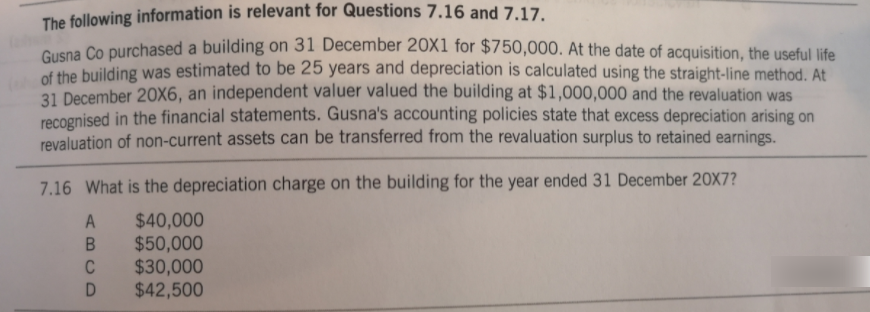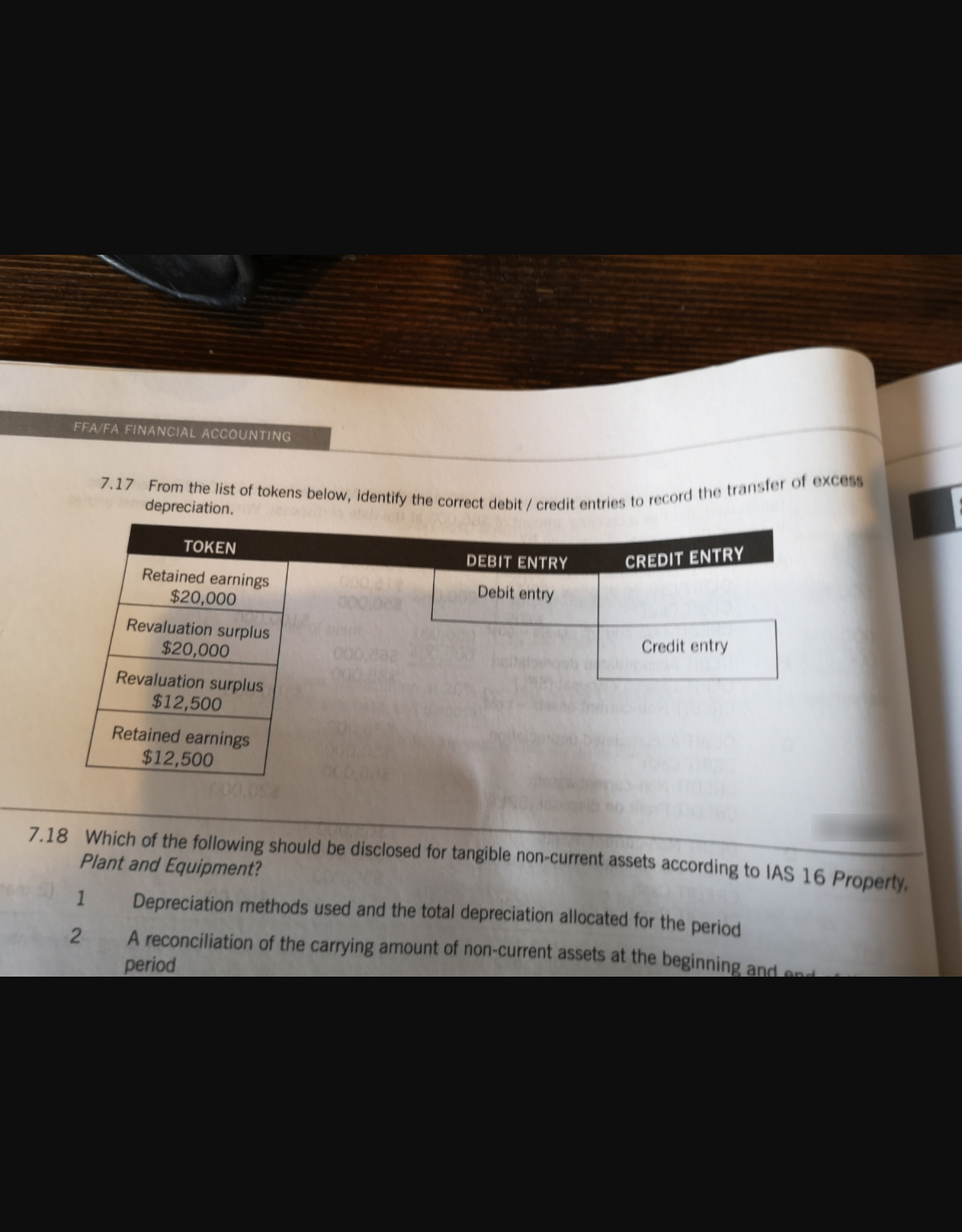The following information is relevant for Questions 7.16 and 7.17. Gusna Co purchased a building on 31 December 20x1 for $750,000. At the date of acquisition, the useful life of the building was estimated to be 25 years and depreciation is calculated using the straight-line method. At 31 December 20X6, an independent valuer valued the building at $1,000,000 and the revaluation was recoenised in the financial statements. Gusna's accounting policies state that excess depreciation arising on revaluation of non-current assets can be transferred from the revaluation surplus to retained earnings. 7.16 What is the depreciation charge on the building for the year ended 31 December 20X7? $40,000 $50,000 $30,000 $42,500 A C 7.17 From the list of tokens below, identify the correct debit / credit entries to record the transfer of excess FFA/FA FINANCIAL ACCOUNTING depreciation. TOKEN CREDIT ENTRY DEBIT ENTRY Retained earnings $20,000 Debit entry 000,0ea Revaluation surplus Credit entry $20,000 Revaluation surplus $12,500 Retained earnings $12,500 7.18 Which of the following should be disclosed for tangible non-current assets according to IAS 16 Property. Plant and Equipment? 1 Depreciation methods used and the total depreciation allocated for the period 2 A reconciliation of the carrying amount of non-current assets at the beginning and end period
The following information is relevant for Questions 7.16 and 7.17. Gusna Co purchased a building on 31 December 20x1 for $750,000. At the date of acquisition, the useful life of the building was estimated to be 25 years and depreciation is calculated using the straight-line method. At 31 December 20X6, an independent valuer valued the building at $1,000,000 and the revaluation was recoenised in the financial statements. Gusna's accounting policies state that excess depreciation arising on revaluation of non-current assets can be transferred from the revaluation surplus to retained earnings. 7.16 What is the depreciation charge on the building for the year ended 31 December 20X7? $40,000 $50,000 $30,000 $42,500 A C 7.17 From the list of tokens below, identify the correct debit / credit entries to record the transfer of excess FFA/FA FINANCIAL ACCOUNTING depreciation. TOKEN CREDIT ENTRY DEBIT ENTRY Retained earnings $20,000 Debit entry 000,0ea Revaluation surplus Credit entry $20,000 Revaluation surplus $12,500 Retained earnings $12,500 7.18 Which of the following should be disclosed for tangible non-current assets according to IAS 16 Property. Plant and Equipment? 1 Depreciation methods used and the total depreciation allocated for the period 2 A reconciliation of the carrying amount of non-current assets at the beginning and end period
Intermediate Accounting: Reporting And Analysis
3rd Edition
ISBN:9781337788281
Author:James M. Wahlen, Jefferson P. Jones, Donald Pagach
Publisher:James M. Wahlen, Jefferson P. Jones, Donald Pagach
Chapter11: Depreciation, Depletion, Impairment, And Disposal
Section: Chapter Questions
Problem 7E: Loban Company purchased four cars for 9,000 each and expects that they will be sold in 3 years for...
Related questions
Question
Question 7.17 please explained in detail.

Transcribed Image Text:The following information is relevant for Questions 7.16 and 7.17.
Gusna Co purchased a building on 31 December 20x1 for $750,000. At the date of acquisition, the useful life
of the building was estimated to be 25 years and depreciation is calculated using the straight-line method. At
31 December 20X6, an independent valuer valued the building at $1,000,000 and the revaluation was
recoenised in the financial statements. Gusna's accounting policies state that excess depreciation arising on
revaluation of non-current assets can be transferred from the revaluation surplus to retained earnings.
7.16 What is the depreciation charge on the building for the year ended 31 December 20X7?
$40,000
$50,000
$30,000
$42,500
A
C

Transcribed Image Text:7.17 From the list of tokens below, identify the correct debit / credit entries to record the transfer of excess
FFA/FA FINANCIAL ACCOUNTING
depreciation.
TOKEN
CREDIT ENTRY
DEBIT ENTRY
Retained earnings
$20,000
Debit entry
000,0ea
Revaluation surplus
Credit entry
$20,000
Revaluation surplus
$12,500
Retained earnings
$12,500
7.18 Which of the following should be disclosed for tangible non-current assets according to IAS 16 Property.
Plant and Equipment?
1
Depreciation methods used and the total depreciation allocated for the period
2
A reconciliation of the carrying amount of non-current assets at the beginning and end
period
Expert Solution
This question has been solved!
Explore an expertly crafted, step-by-step solution for a thorough understanding of key concepts.
Step by step
Solved in 2 steps with 2 images

Knowledge Booster
Learn more about
Need a deep-dive on the concept behind this application? Look no further. Learn more about this topic, accounting and related others by exploring similar questions and additional content below.Recommended textbooks for you

Intermediate Accounting: Reporting And Analysis
Accounting
ISBN:
9781337788281
Author:
James M. Wahlen, Jefferson P. Jones, Donald Pagach
Publisher:
Cengage Learning

Principles of Accounting Volume 1
Accounting
ISBN:
9781947172685
Author:
OpenStax
Publisher:
OpenStax College


Intermediate Accounting: Reporting And Analysis
Accounting
ISBN:
9781337788281
Author:
James M. Wahlen, Jefferson P. Jones, Donald Pagach
Publisher:
Cengage Learning

Principles of Accounting Volume 1
Accounting
ISBN:
9781947172685
Author:
OpenStax
Publisher:
OpenStax College



Financial Accounting: The Impact on Decision Make…
Accounting
ISBN:
9781305654174
Author:
Gary A. Porter, Curtis L. Norton
Publisher:
Cengage Learning
